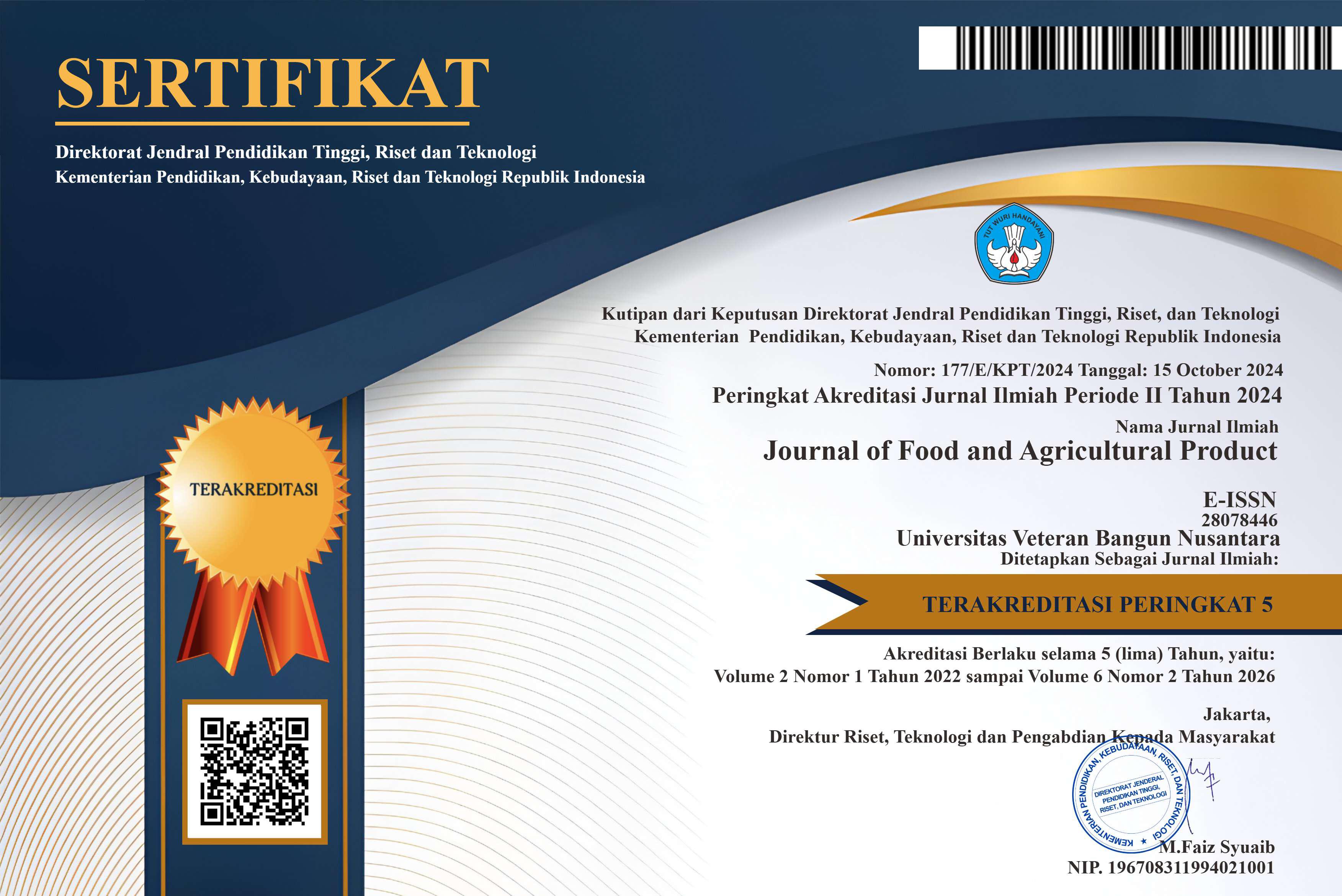Antioxidant Potential of Tomato Extract and Moringa Leaf Extract
DOI:
https://doi.org/10.32585/jfap.v1i2.1852Abstract
Tomatoes have bioactive components which are a source of antioxidants that can prevent damage to the body. In addition, Moringa leaves also contain bioactive compounds such as polyphenols, flavonoids, ascorbic acid, and isothiocyanates that can increase the body's immune response and inhibit the activation of carcinogenesis. The content of bioactive compounds contained in tomatoes is lycopene, beta carotene, phenol, vitamin C, flavonoids. Tomatoes are also rich in antioxidants. While Moringa leaves are rich in bioactive compounds and antioxidants. Bioactive compounds found in Moringa leaves are phenols, flavonoids, chlorophyll, saponins, vitamin C. Tomatoes play a role in health by reducing the risk of oxidative stress, cancer, cardiovascular, diabetes, reducing hypertension, a direct modulator of vascular resistance through its action as a vasodilator. Moringa leaves also have the potential as antihyperglycemic, so they can control blood sugar, antibacterial activity, fight colds and flu, increase and facilitate breast milk production, as well as antimalarials and antioxidants.Downloads
References
Arifin, B., & Ibrahim, S. (2018). Struktur, bioaktivitas dan antioksidan flavonoid. Jurnal Zarah, 6(1), 21-29.
Awaliyah, F., & Rostwentivaivi, V. (2021). Analisis biaya dan pendapatan usaha tani tomat di kabupaten garut. Mahatani: Jurnal Agribisnis (Agribusiness and Agricultural Economics Journal), 4(1), 373-383.
Berawi, K. N., Wahyudo, R., & Pratama, A. A. (2019). Potensi terapi Moringa oleifera (Kelor) pada penyakit degeneratif. Jurnal Kedokteran Universitas Lampung, 3(1), 210-214.
BPOM. (2004). Decree of the Head of the Food and Drug Supervisory Agency Number Hk.00.05.23.3644 concerning the Basic Provisions for the Supervision of Food Supplements. 219.
Damayanthi, E., Kustiyah, L., Khalid, M., & Farizal, H. (2010). Antioxidant activity rice bran higher than tomato juice and the decreasing of total antioxidant activity serum after high antioxidant beverage intervention. Jurnal Gizi dan Pangan, 5(3), 205-210.
Dewi, A. P. (2019). Determination of vitamin c levels by uv-vis spectrophotometry in various varieties of tomatoes. JOPS (Journal Of Pharmacy and Science),2(1), 9–13.
Eveline, E., Siregar, T. M., & Sanny, S. (2014). Studi Aktivitas Antioksidan Pada Tomat (Lycopersicon esculentum) Konvensional Dan Organik Selama Penyimpanan. Prosiding SNST Fakultas Teknik, 1(1).22-28.
Ferreira, P. M. P., Farias, D. F., Oliveira, J. T. D. A., & Carvalho, A. D. F. U. (2008). Moringa oleifera: bioactive compounds and nutritional potential. Revista de Nutrição, 21, 431-437.
Fitriana, W. D., Ersam, T., Shimizu, K., & Fatmawati, S. (2016). Antioxidant activity of Moringa oleifera extracts. Indonesian Journal of Chemistry, 16(3), 297-301.
Ghadage, S. R., Mane, K. A., Agrawal, R. S., & Pawar, V. N. (2019). Tomato lycopene: Potential health benefits. The Pharma Innovation Journal, 8(6), 1245-1248.
Hanson, P. M., Yang, R. Y., Wu, J., Chen, J. T., Ledesma, D., Tsou, S. C., & Lee, T. C. (2004). Variation for antioxidant activity and antioxidants in tomato. Journal of the American Society for Horticultural Science, 129(5), 704-711.
Johan, H., Anggraini, R. D., & Noorbaya, S. (2019). Potensi Minuman Daun Kelor Terhadap Peningkatan Produksi Air Susu Ibu (ASI) PAda Ibu Postpartum. Sebatik, 23(1), 192-194.
Kursia, S., Aksa, R., & Nolo, M. M. (2018). Potensi antibakteri isolat jamur endofit dari daun kelor (Moringa oleifera Lam.). Pharmauho: Jurnal Farmasi, Sains, dan Kesehatan, 4(1). 30–33
Lin, M., Zhang, J., & Chen, X. (2018). Bioactive flavonoids in Moringa oleifera and their health-promoting properties. Journal of functional foods, 47, 469-479.
Lukmanto, C. M. E. (2016). Konsep Agrikultur Sebagai Penyelesaian dari Isu Pertanian. Jurnal Sains dan Seni ITS, 4(2), 82–87.
Mu’nisa, A. (2012). Analisis kadar likopen dan uji aktivitas antioksidan pada tomat asal Sulawesi Selatan. Bionature, 13(1), 62–66.
Samad, M. Y. (2012). Pengaruh penanganan pasca panen terhadap mutu komoditas hortikultura. Jurnal Sains dan Teknologi Indonesia, 8(1), 31–36.
Nararya, S. A. (2015). Uji Toksisitas Daun Kelor (Moringa oleifera) Terhadap Sel Fibroblas Gingiva Menggunakan Uji MTT assay. Jurnal Biosains Pascasarjana, 17(1), 52-58.
Nisa, K., & Surbakti, E. S. B. (2016). Tomat (Lycopersicum esculentum Mill.) sebagai anti penuaan kulit. Jurnal Majority, 5(3), 73-78.
Putra, I. W. D. P., Dharmayudha, A. A. G. O., & Sudimartini, L. M. (2016). Identifikasi Senyawa Kimia Ekstrak Etanol Daun Kelor (Moringa oleifera L) di Bali. Indonesia Medicus Veterinus, 5(5), 464-473.
Ramadhian, M. R., & Hasibuan, N. C. (2016). Efektivitas kandungan kalium dan likopen yang terdapat dalam tomat (Solanum lycipersicum) terhadap penurunan tekanan darah tinggi. Majority, 5(3), 124–128.
Rosyidah, A. Z., & Ismawati, R. (2016). Studi tentang tingkat kesukaan responden terhadap penganekaragaman lauk pauk dari daun kelor (Moringa oleivera). E-journal Boga, 5(1), 17-22.
Ried, K., Frank, O. R., & Stocks, N. P. (2009). Dark chocolate or tomato extract for prehypertension: a randomised controlled trial. BMC complementary and alternative medicine, 9(22), 1-12.
Rizkayanti, R., Diah, A. W. M., & Jura, M. R. (2017). Uji aktivitas antioksidan ekstrak air dan ekstrak etanol daun kelor (Moringa oleifera LAM). Jurnal Akademika Kimia, 6(2), 125-131.
Sankhyan, N. I. D. H. I., Sharma, A. N. S. H. U. L., Seth, C. A., Chauhan, A. N. J. A. L. I., & Kulshrestha, S. (2013). Determination and comparison of vitamin C content from Moringa oleifera by different methods. International Journal of Agricultural Science and Research, 3(2), 67-70.
Veronica, E., Amelia, I., Yunatan, K. A., Chrismayanti, N. K. S. D., & Mahendra, A. N. (2020). Potensi Kombinasi Ekstrak Daun Kelor (Moringa oliefera) dan Artemisia (Artemisia annua) Sebagai Antimalaria Plasmodium falciparum. Jurnal Ilmiah Kesehatan Sandi Husada, 9(2), 831-841.
Wati, ES, Febrianti, N., & Dhaniaputri, R. (2016). The content of ascorbic acid and phenol in red tomatoes and purple tomatoes as a source for learning biology in class xi high school. Journal of the Symposium on Biology Education, 2(2), 621–628.
Wijayati, M., Saptarini, N. M., Herawati, I. E., & Suherman, S. E. (2014). Formulation of dried aloe vera effervescent extract granules as food supplement. Journal of Pharmaceutival Science and Technology, 1(1), 1–6.
Xu, Y. B., Chen, G. L., & Guo, M. Q. (2019). Antioxidant and anti-inflammatory activities of the crude extracts of Moringa oleifera from Kenya and their correlations with flavonoids. Antioxidants, 8(8), 296. https://doi.org/10.3390/antiox80802961-12.




